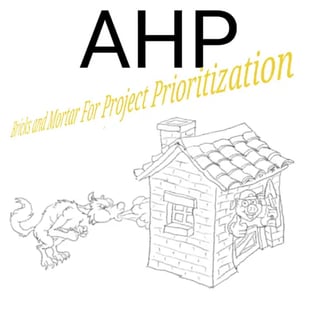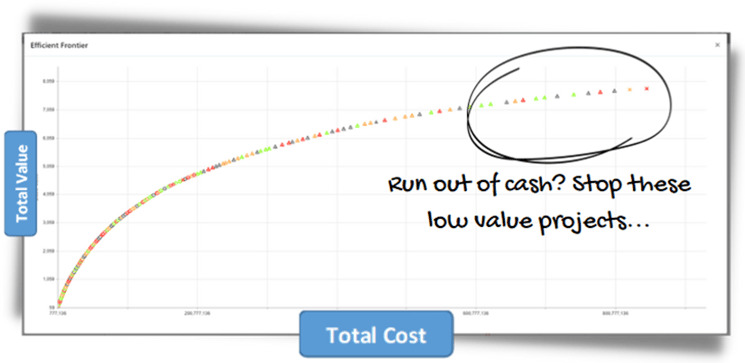AHP: The foundation for a great portfolio in just 8 weeks
Updated:
Published:
 I used to tell my kids the story of the three little pigs - the one with the houses made of straw, sticks and bricks, and the big bad wolf with the attitude problem. The little pigs who used straw and sticks probably did a great job in planning their houses, perhaps with a Gantt chart and milestones mapped out, but (spoiler alert) they were destined to become homeless from the moment they picked the wrong materials.
I used to tell my kids the story of the three little pigs - the one with the houses made of straw, sticks and bricks, and the big bad wolf with the attitude problem. The little pigs who used straw and sticks probably did a great job in planning their houses, perhaps with a Gantt chart and milestones mapped out, but (spoiler alert) they were destined to become homeless from the moment they picked the wrong materials.
And it's the same thing with project prioritization.
A backlog built of the wrong projects will get flattened as soon as the CEO does a bit of huffing and puffing.
It could be that you've included low value projects which are obsolete from the start. Or you've got no hope of completing work on time because you've said "yes" to everything. Either way you’re wolf food, because you're using the wrong building blocks, no matter how well you plan or escalate once delivery is up and running.
Conversely, let’s think about the little pig who built his portfolio using prioritization. He only picked important projects because his model was aligned to strategy, and he never had overruns because he only committed to a deliverable number of projects.
Sound too good to be true? All you need is AHP - the Analytic Hierarchy Process. Use it to create your very own supply of bricks, which will form the basis of a robust process for wolf-proofing your portfolio.
And this is so much easier that replacing your PPM or rebuilding your entire planning process. You can do this in just 8 weeks. That’s two months of fixing for a lifetime of not being eaten.
Here’s how in 5 steps:
1. Make a plan
Get the right people in the room to define what success means. Reflect on how planning works (or does not work) in your organization. We recommend a simple 3 P’s framework as a place to start:
- Process: How does the prioritization exercise align to the allocation of resources? What scope / timeframe does this imply? Who needs to be involved?
- Politics: Who are the key stakeholders? Is there good alignment between teams? What changes are needed to ways of working? A good sponsor is critical to make change happen.
- Projects: What is the size and scope of the backlog under review? Decide if you are prioritizing projects, programs, features… or something else, and avoid mixing within the same model.
This can happen in 1 week, or longer for a more complex portfolio, but resist the temptation to skip it as it will make everything else work far better.
2. Build & Weight Criteria with Leadership
Building an AHP model is not rocket science (unless, like NASA, you’re using it to support your space missions). Follow these steps:
- Review your current portfolio for Pros & Cons: Learn about what the key business drivers are for your business stakeholders. Ask project sponsors what they are trying to achieve and look for patterns across the business. Perhaps it's about operational efficiency or winning market share, or probably a bit of both.
- Use existing Strategic Goals: Strategic Goals are excellent as a base for Criteria: they're essentially doing the same thing with a different methodology. It's also going to help you get the CEO to buy-in when you show that it's their strategy that prioritization is going to accelerate.
- Exclude cost from your criteria hierarchy: Once AHP has helped you identify the value of each project, you will then introduce the cost element. Value divided by cost is a really useful value to use when picking projects, for example, as it shows you which projects deliver the biggest bang for the buck. There are some other AHP rules to be aware of, but it's mostly just common sense.
- Let us help you get started: We have built 80+ core criteria into our software, and written a guide on how to apply them to support virtually any use case. Don't start from scratch.
- Agree on Criteria: Get an agreement on the criteria you are going to use to prioritize your projects. If people see that important criteria are missing, they won’t feel comfortable with the whole process. Put another way, if you don’t agree on criteria, you won’t agree on the results.
- Use pairwise comparisons to weight your model: When you have your criteria agreed it is time to prioritize them. AHP gives you a powerful way of doing this prioritization – pairwise comparison. This is also great way to continue driving alignment within the leadership group, as it's a chance for competing voices to learn from one another.
If you’re pushing it, this can be done inside 3 weeks. Longer is fine if you need change to be more gradual to give people time to reflect. It’s critical to get quality time with your leadership team to ensure you fully realize the value of journey, or as one client’s CEO put it: “We’re having conversations we should have had years ago”.
3. Get Project Level Data
Clearly you're going to need to get data - here's the shopping list to build that wolf-proof process:
-
Where do my projects come from?: If you have a PPM system with a set of projects in then plug it in. If you want to drive ideation from within your organization then set up a simple project request page. Or simply get a group together to brainstorm projects as a team. Don't forget when it comes to identifying winning projects, it's your mid-level managers who know what's best, so make sure you're tapping into their insight.
One special tip here, don't prioritize every project request. Eliminate proposals that are not ready to be prioritized or shouldn't be prioritized at all. For example, you may block projects that are too risky, not aligned with strategy, don’t comply with legal requirements, or are not clearly defined. Similarly, you may need a project because of new legal regulations. You don’t need prioritize it, if you have no option of saying no.
- What are your resource constraints? Cost should not be in your AHP model - it's a constraint you're going to use when you pick the best value for money portfolio. But capturing this data is critical, so don't forget this step. Estimates can be simple T-Shirt Sized, or detailed bottom up views. They can also be individual estimates or team generated ones. You can even add bottleneck analysis, by identifying the type of resource needed for each project, so you don't overload a team and end up with an undeliverable plan. For a complex portfolio this can provide a great application for AI Optimization.
- What other flags or lenses do you need for analysis? Overlaying a reporting hierarchy or requesting team is often important, especially if you have a ‘spaghetti-mess’ problem. Identifying mandatory projects is also often important.
This can all happen in parallel to your criteria build, so aim to have in place by week 4.
4. Get Scoring
It’s important not to rush this step as it’s where a lot of the magic happens, when people compare votes and learn from one another. That said a well-structured model shares the workload, so folks can score in parallel across different projects and criteria.
- Generate personalized questionnaires: Having 3+ people reduces Noise in scoring by 50%, and should be a minimum target per question. Find the right people for the right questions - have the engineers cover technical features, and the marketeers assess customer engagement. If you've got an ongoing review process, set this up to automate data collection.
- Chase compliance: Track completion; for a new process people may need to some 'encouragement' to get their work done, as they build the muscle memory needed to commit to a new way of working. Once they get started they'll realize it's easy, and a great way to have their say. Use a handy guide to step them through how it's done.
- Build Alignment: Once you have judgements identify where there is real disagreement. With the issue is on the table, it forces everyone to listen to different viewpoints and then explore what the “right” answer is. The result of this is “fact based” decisions. Because everyone was part of the prioritization process, and because everyone ends up buying in to the priorities that you agree, the projects that are selected get much better support from the whole organization. This is more than consensus – it’s driving alignment across the whole organization. In fact, many customers tell us that this is the part of the process that delivers the most value. Getting the whole team aligned is worth the price of entry on its own.
Allow 2 weeks for this process, or longer if you're colleagues are going to be slow, but try to keep focus as this is good for driving change.
5. Choose the best portfolio
Once you have all the data structured into dashboards this step is far simpler than it has ever been before. Use the ‘Efficient Frontier’ view to identify the best projects, by ranking based on value for money. This gives you the '80:20' split for maximizing portfolio value while saving precious resources.

Or apply an algorithm to pick the best combination of projects if you have multiple constraints to manage. Don’t forget you can prioritize start date too. Having a portfolio of projects all start on January 1st isn’t helpful.
Far better to map out a month-by-month plan that optimizes resources and creates a realistic set of commitments to hold people to account. This is another place AI can do the hard work (so you don't have to).
With the right tools, this can all happen in an hour. However, we recommend allowing 2 weeks, so people have time to reflect and feedback, and develop buy-in to the outcome. Offering the leadership team different scenarios is also often a good idea.
So that’s 8 weeks of focus for a wolf-free plan.
For those of you starting on this journey you will always hear (at least) one colleague challenge you – “couldn’t we just do this in a spreadsheet / meeting room / PPM tool”? We don’t have time to do this right now. Here the reply should be simple. It might be quicker to build a house from straw (or sticks) but how much time will you waste re-building that house again and again as your construction fails to withstand the rigors of a big bad wolf? Surely, it’s far better to deliver quality at pace than to stick with a solution that doesn’t work.
AHP is providing the foundations for an agile way of governing your portfolio that will keep you safe no matter how much your CEO huffs and puffs. We believe it is the bricks and mortar for effective project prioritization, so why waste time on building with anything else?
Ready to learn more? Read more about our 8-week plan here in our Deployment Guide or book a meeting with us to talk through your use case.
